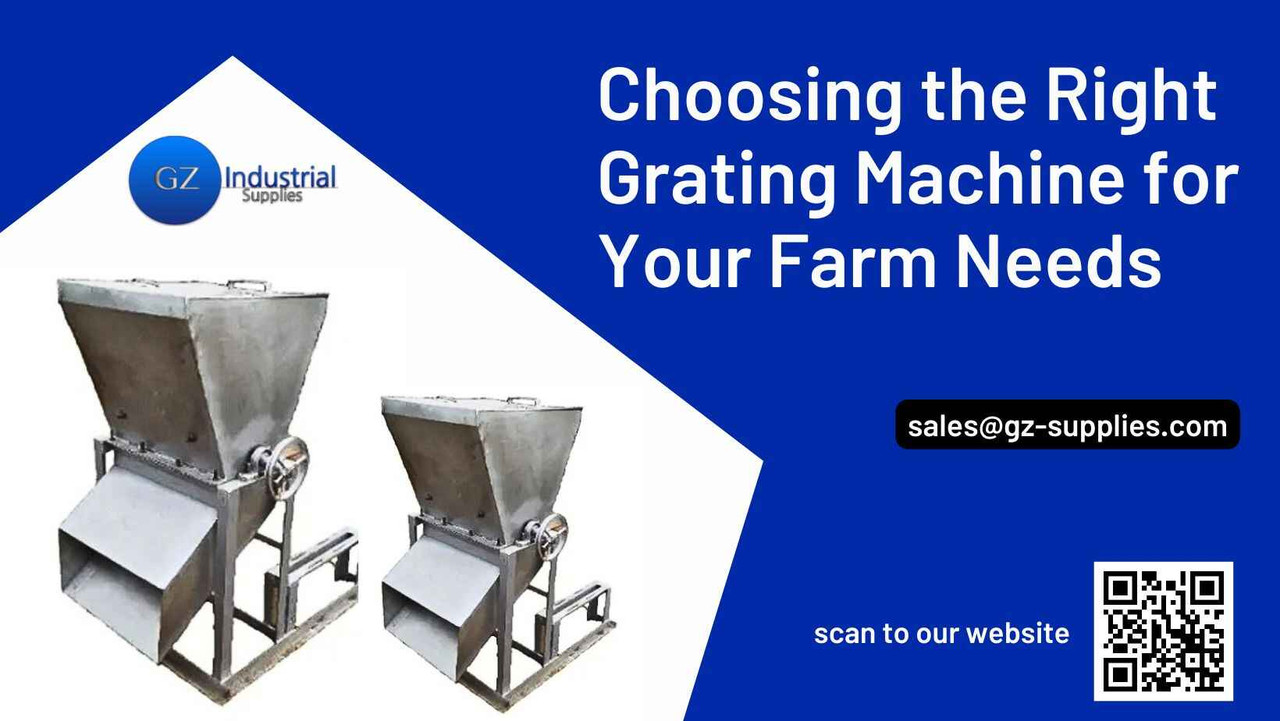Choosing the Right Grating Machine for Your Farm Needs
Key Takeaway
- Crop type suitability: Choose a grating machine designed for the specific crops you grow, such as cassava, yam, or coconut, to ensure efficient processing.
- Capacity and scale: Consider the size and processing capacity of the machine based on your farm’s production volume, whether small, medium, or large-scale.
- Motorized vs. manual: Motorized grating machines offer faster processing and are ideal for larger operations, while manual models are better suited for small-scale farms.
Introduction
In today's rapidly evolving agricultural landscape, agricultural machinery plays a crucial role in increasing productivity and reducing labor-intensive tasks. Grating machines, in particular, are essential for processing a variety of crops, helping farmers handle larger volumes with ease. These machines significantly improve efficiency by speeding up the process of preparing grated materials for different uses—whether for food processing, animal feed, or industrial applications.
A properly chosen grating machine can streamline operations, minimize waste, and ensure product consistency. From smallholder farms to large commercial agricultural setups, these machines allow for faster, more uniform grating, saving valuable time and resources.
This guide will walk you through the key considerations for choosing the right grating machine for your farm's specific needs. We'll cover the different types of machines available, the factors that should influence your decision, and tips for making an informed purchase. By the end, you'll have a clear understanding of how to select the best machine for your operations.
Stainless Gasoline Grating Machine 6.5hp Hellog
Types of Grating Machines Available
1. Manual Grating Machines
Manual grating machines are ideal for smaller farms or operations where the power supply is limited. These machines are operated by hand, often using a crank or lever to shred or grate crops. While they are slower than their electric counterparts, manual machines offer affordability and simplicity.
Pros:
1. Cost-effective for small-scale farmers.
2. Easy to maintain, with fewer mechanical parts.
3. Portable and does not require electricity.
Cons:
1. Requires physical effort, which can be labor-intensive.
2. Slower grating speed, limiting output for larger farms.
2. Electric Grating Machines
Electric grating machines are a step up from manual versions, offering faster operation and more consistency in grating. Powered by electricity, these machines are suitable for medium- to large-scale farms that need to process larger volumes of crops. Electric machines can handle a variety of crop types, making them versatile and highly efficient.
Pros:
1. Faster processing compared to manual machines.
2. Requires minimal physical effort.
3. Capable of handling larger quantities of crops.
Cons:
1. More expensive upfront.
2. Requires access to a stable power supply.
3. May need more maintenance and repair over time.
3. Hydraulic or Industrial Grating Machines
For large-scale or industrial farm operations, hydraulic grating machines are the preferred choice. These machines use powerful hydraulics to grate large volumes of crops efficiently, making them suitable for farms that process hundreds or thousands of kilograms daily. Industrial grating machines are designed to work continuously without overheating or breaking down, which is essential for heavy-duty operations.
Pros:
1. High capacity, capable of handling large volumes.
2. Fast and efficient, saving time for large-scale farmers.
3. Durable and designed for long-term use.
Cons:
1. High initial cost.
2. Requires specialized training for operators.
3. More complex to maintain and repair.
Grating machine 1ton/hr Hellog
4. Specialized Grating Machines
Some machines are designed for specific crops like cassava, yams, or potatoes. These specialized grating machines ensure optimal processing for certain textures and types of produce. They are tailored to the crop’s unique properties, ensuring minimal waste and maximum output.
Pros:
1. Highly efficient for specific crops.
2. Optimized design for specialized grating needs.
3. Produces uniform grated material, ideal for food processing or commercial purposes.
Cons:
1. Limited versatility; may not work well with other crops.
2. May be more expensive than general-purpose machines.
Key Factors to Consider When Choosing a Grating Machine
1. Farm Size and Crop Type
The size of your farm and the type of crops you grow are key factors when choosing a grating machine. Small-scale farms might only need a manual or small electric machine, while large commercial farms would benefit from industrial or hydraulic machines. The crop type also plays a role; for example, root crops like cassava and yams may require more robust machines due to their tougher texture, while soft crops can be processed with lighter-duty equipment.
2. Power Source and Availability
When considering the power source, it’s essential to evaluate the availability of electricity or fuel on your farm. Manual machines don't require electricity, making them suitable for remote farms. Electric grating machines, however, are highly efficient but depend on reliable power. In areas where electricity is scarce, a gasoline-powered machine might be a better option.
3. Cost vs. Benefit
While it may be tempting to choose the cheapest machine, it's important to balance the initial cost with the long-term benefits. Cheaper machines may save you money upfront but could result in higher maintenance costs or shorter lifespans. More expensive machines tend to offer greater efficiency, higher durability, and better long-term returns, especially for larger farms.
4. Durability and Build Quality
Durability is critical when selecting a grating machine, especially for farms operating in challenging environments. Machines made from high-quality materials, such as stainless steel or heavy-duty plastic, are more resistant to rust, wear, and tear. Additionally, machines from reputable brands usually offer better build quality and longer warranties.
5. Maintenance and Ease of Use
When selecting a grating machine, consider how easy it will be to maintain and operate. Machines with complex parts may require specialized technicians for repairs, which could increase downtime on your farm. Simpler machines, on the other hand, can often be fixed by the farmer or local mechanics.
Ease of use is another critical factor, especially if you plan on having workers operate the machine. Machines with intuitive designs and clear operating instructions reduce the risk of user error and accidents. Training workers on a machine that is straightforward and user-friendly ensures smoother operation and higher productivity.
6. Safety Features
Given the heavy-duty nature of farm equipment, safety is paramount. Always check that the grating machine includes essential safety features, such as:
1. Emergency stop buttons.
2. Protective guards to prevent contact with moving parts.
3. Anti-slip bases or stands for stability.
4. Overload protection to prevent the machine from overheating.
Ensuring that your machine has these features will reduce the risk of accidents and ensure that it complies with safety regulations.
Cassava Grating Machine
Tips for Making the Final Decision
1. Testing the Machine Before Purchase
If possible, test the grating machine before committing to a purchase. This is especially crucial for high-end or industrial machines. Test-runs allow you to assess the machine’s performance, speed, and ease of use in real farm conditions. Does the machine handle your crops efficiently? Is the grating consistent, and does the machine match your farm’s production scale? Testing also lets you check for any potential issues or limitations the machine may have before investing in it.
2. Seeking Expert Opinions
Before making a purchase, it's wise to consult local experts, agricultural extension officers, or experienced farmers who may have already gone through the process of selecting a grating machine. Their insights can be invaluable in pointing you toward reliable brands, avoiding common mistakes, and making a more informed decision.
Additionally, reading online reviews, testimonials, or product comparisons can give you a broader perspective. Manufacturers often provide detailed information about the specifications of their machines, but real-world feedback from farmers using the machine can provide a more practical understanding of its performance.
3. Considering Future Needs
It’s important to think long-term when purchasing a grating machine. As your farm grows, your processing needs may change. Choosing a machine that can handle an increase in production capacity or work with multiple crops could save you the expense of buying a second machine later on. Look for versatile machines that offer adjustable settings, which can be modified as your farming needs expand.
For example, if you plan to diversify your crops in the future, investing in a machine that can handle a variety of textures and sizes may be more beneficial. Consider also whether the machine has the potential for upgrades or attachments that can be added later on to enhance its functionality.
Case Studies: Real-Life Examples of Successful Grating Machine Choices
1. Small-Scale Farmers: The Value of Manual or Low-Cost Machines
Smallholder farmers often operate on limited budgets, but manual grating machines can be a highly effective and affordable solution. For example, a cassava farmer in rural Nigeria increased her productivity by 50% simply by upgrading from hand-grating to a manual machine. Despite its lower cost, the machine provided much-needed efficiency for a family-operated farm, helping them process their crop faster and sell more products at local markets.
2. Medium-Sized Farms: Balancing Efficiency and Cost with Electric Machines
A mid-sized potato farm in Kenya invested in an electric grating machine to process their annual harvest. The machine’s speed and ease of use allowed them to process large quantities in half the time it previously took with manual labor. Though the upfront cost was significant, the investment paid off in increased productivity and lower labor costs, allowing the farm to scale its operations and reach larger markets.
3. Large-Scale Farms: The Power of Industrial Machines
For a large cassava processing operation in Brazil, an industrial hydraulic grating machine was the key to meeting high production demands. Capable of processing several tons of cassava per day, the machine allowed the company to streamline its entire operation and export processed cassava products internationally. The high initial cost was offset by increased revenue and reduced labor costs, as fewer workers were needed to manage the machine.
Other Related Articles
Top 5 Agricultural Machinery: The Role of Grating Machines
Where to buy cassava grating machine in Nigeria, Near me
Conclusion
Choosing the right grating machine for your farm depends on several factors, including the size of your farm, the type of crops you grow, your available budget, and the power source options. From manual machines suited for small operations to hydraulic or industrial machines ideal for large-scale farms, selecting the appropriate equipment is key to improving productivity, reducing labor, and ensuring long-term cost savings.
Ready to boost your farm’s efficiency with the right grating machine? Visit GZ Industrial Supplies today to explore a wide selection of high-quality grating machines tailored to your specific farm needs. Whether you're processing cassava, yams, or other crops, we have the perfect machine to suit your scale and budget. Equip your farm with the best tools for greater productivity and profitability!











